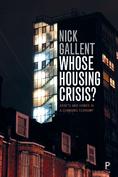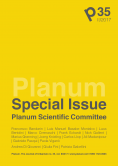city-regions social housing strategic planning outskirts & suburbs economics ecology urban projects citizenship città storica inu study day simulation maps premio gubbio 2018 premio letteratura urbanistica tourism ifau2018 resilience paesaggio identity special news tools and techniques Environment news land use culture
Whose Housing Crisis?
Assets and Homes
in a Changing Economy
Nick Gallent
At the root of the housing crisis is the problematic relationship that individuals and economies share with residential property.
Housing’s social purpose, as home, is too often relegated behind its economic function, as asset, able to offer a hedge against weakening pensions or source of investment and equity release for individuals, or guarantee rising public revenues, sustain consumer confidence and provide evidence of ‘growth’ for economies. The refunctioning of housing in the twentieth century is a cause of great social inequality, as housing becomes a place to park and extract wealth and as governments do all they can to keep house prices on an upward track.
Whose Housing Crisis focuses, broadly, on the financialised and monetarised demand for housing as asset versus the need for homes: it explores the tensions, inequalities and risks that this mixed rationale for housing consumption produces. As part of that focus, it tracks the key narratives (competing explanations of our predicament) behind this unanswered housing question:
• First, too few new homes are being built for a mix of reasons - including a slow and locally-politicised planning process, and the failure of house-builders to get on and deliver the housing we need, mainly because building and selling housing is less profitable than trading in land (or so the story goes);
• Second, the housing market is too open to overseas investors and this form of consumption is driving a cost crisis and accentuating the tensions arising from a lack of new supply;
• Third, we’re too reliant on private house-building and private consumption. The loss of a public housing component is core to the current housing crisis (in England and the rest of the UK, this includes the right to buy since 1980 and the lack of new council housing over the last 40 years);
• Fourth, the lack of ‘plurality’ (mixed development models) within the private sector – too much volume build and too little space for smaller builders and self-build – means a low level of systemic resilience: a cycle of boom and bust amplified by investor behaviour, funding and finance arrangements unsuited to niche providers, smaller development opportunities being missed, the needs of some (rural) areas - where small sites are the norm - not being met, etc.;
• Fifth, the tax system is ‘gumming up’ the housing market. Up-front costs – tax payable on purchase – are too high and, at the same time, how we tax the un-earnt income from housing, relative to other assets (and also relative to work), drives over-investment and the cost crisis;
• And sixth, it’s all about credit and debt: credit supply (in the form of domestic mortgages) pushes up asset prices and debt trading fuels the supply of credit: a crucial and problematic circularity at the heart of our relationship with housing.
The final proposition – one of the narratives expanded within the book – captures an essential argument: that housing has been caught up in a set of economic processes that now substitute for growth built on increased labour productivity. Shifting our economic centre of gravity away from housing (and ‘asset sheet growth’), thereby reshaping the function of housing and alleviating the cost crisis, is a tough thing to do. It would also run contrary to a particular view of housing and the housing crisis, as stalled growth in asset ownership (requiring economic correction) rather than a crisis of access to decent homes (requiring a different economic model and an extension of the right to housing).
The central argument in Whose Housing Crisis is that we must accept the inherent 'wickedness' of our housing plight, acknowledge the complexity (and connectedness) of underlying processes and stop looking for easy exits that ignore the role assigned to housing in modern economies – as a place to park wealth for the few, to the detriment of the many.
CONTENTS
List of figures | vii
Key terms | ix
Acknowledgements | xi
Preface | xiii
1. The housing crisis | 1
2. A wicked problem | 23
3. Housing’s economic context | 47
4. Local pathways to crisis | 73
5. Whose housing crisis? | 109
6. An exit strategy | 131
Index | 163
ABOUT THE AUTHOR
Nick Gallent is Professor of Housing and Planning and the Head of the Bartlett School of Planningat UCL, UK. He researches and teaches on urban and rural planning, housing development and policy and on the interactions of communities with housing development and the broader politics of that development. Recent books, besides Whose Housing Crisis, include: Politics, Planning and Housing Supply in Australia, England and Hong Kong (with Nicole Gurran and Rebecca Chiu, Routledge, 2016) and The Routledge Companion to Rural Planning (edited with Mark Scott and Menelaos Gkartzios, Routledge 2019). Nick Gallent is member of Planum Scientific Committee.
Related articles:
Online resources and links




Planum
The Journal of Urbanism
ISSN 1723-0993
owned by
Istituto Nazionale di Urbanistica
published by
Planum Association
ISSN 1723-0993 | Registered at Court of Rome 4/12/2001, num. 514/2001
Web site realized by ChannelWeb & Planum Association | Powered by BEdita 3


